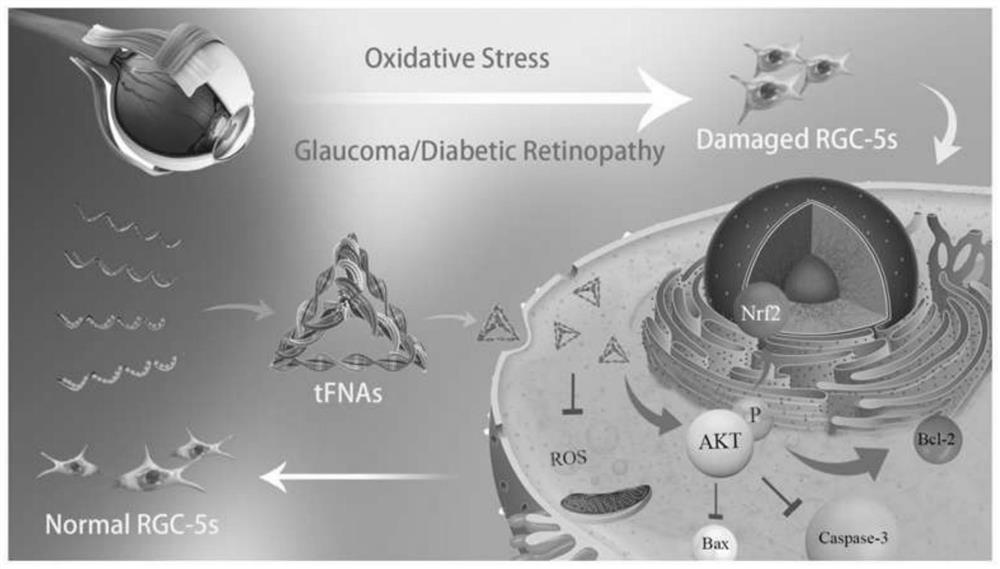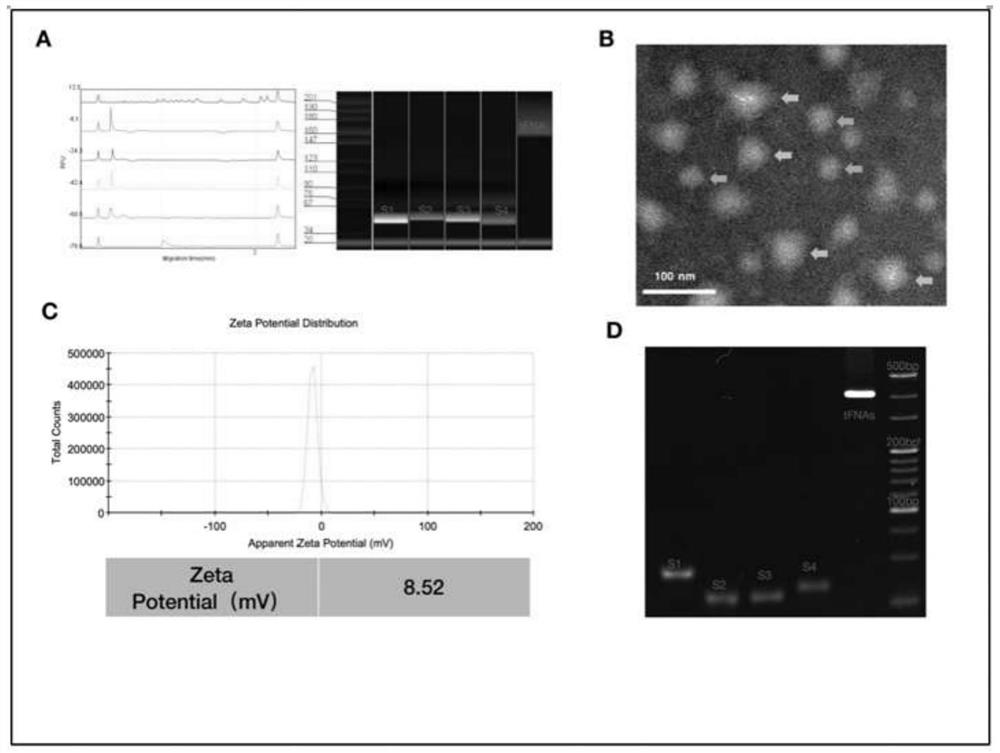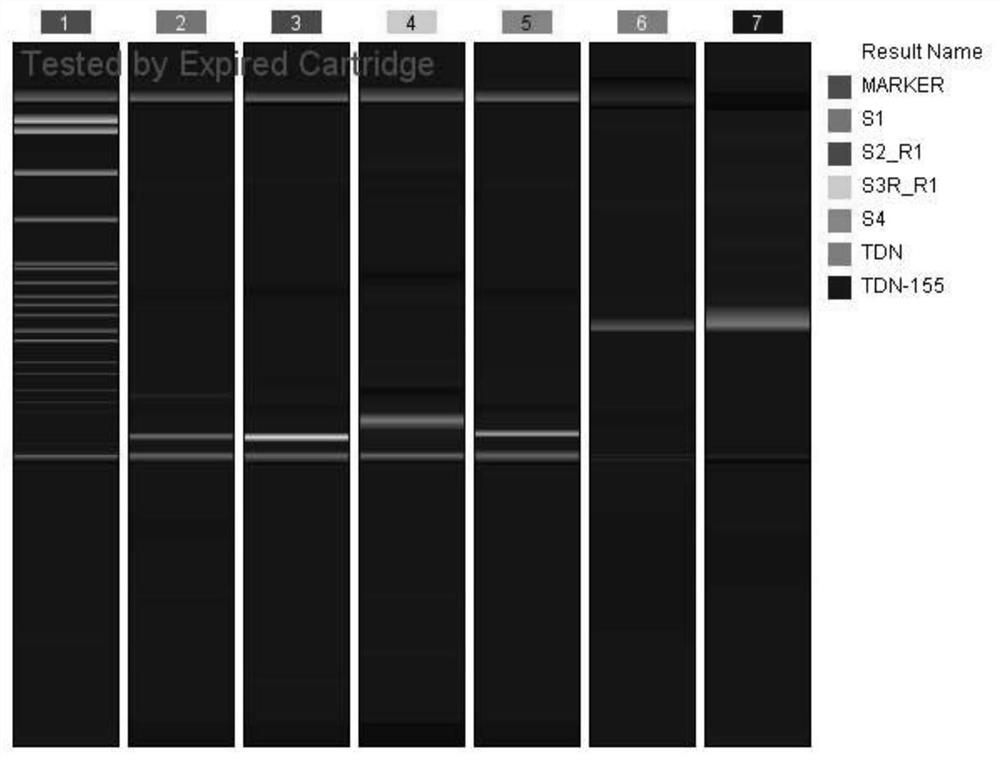Medicine for preventing oxidative stress of retinal ganglion cells and wet macular degeneration
A retinal ganglion and drug technology, which can be used in drug combinations, sensory diseases, pharmaceutical formulations, etc., can solve problems such as DNA tetrahedron or miR-155 that have not yet been seen, and achieve good application prospects, prevention of cell apoptosis, and good protection. Effect
- Summary
- Abstract
- Description
- Claims
- Application Information
AI Technical Summary
Problems solved by technology
Method used
Image
Examples
Embodiment 1
[0039] Synthesis of embodiment 1 tFNA
[0040] 1. Synthesis method
[0041] Dissolve four DNA single strands (S1, S2, S3, S4) in TM Buffer (10mM Tris-HCl, 50mM MgCl 2 ,pH=8.0), the final concentration of the four DNA single strands was 1000nM, mixed thoroughly, rapidly heated to 95°C for 10 minutes, then rapidly cooled to 4°C and maintained for more than 20 minutes to obtain tFNA.
[0042] The sequences of the four single strands (5'→3') are as follows:
[0043] S1: ATTTATCACCCGCCATAGTAGACGTATCACCAGGCAGTTGA
[0044] GACGAACATTCCTAAGTCTGAA (SEQ ID NO. 1);
[0045] S2: ACATGCGAGGGTCCAATACCGACGATTACAGCTGCTACAC
[0046] GATTCAGACTTAGGAATGTTCG (SEQ ID NO. 2);
[0047] S3: ACTACTATGGCGGGTGATAAAACGTGTAGCAAGCTGTAATC
[0048] GACGGGAAGAGCATGCCCATCC (SEQ ID NO. 3);
[0049] S4: ACGGTATTGGACCCTCGCATGACTCAACTGCCTGGTGATAC
[0050] GAGGATGGGCATGCTCTTCCCG (SEQ ID NO. 4).
[0051] The 5' end of S1 is optionally connected with a Cy5 fluorescent labeling group for tFNA tracking.
[0052...
Embodiment 2
[0057] Synthesis of the complex (TDN-155) of embodiment 2 tFNA and miR-155
[0058] 1. Synthesis
[0059] On the basis of Example 1, replace the S3 sequence with the S-S3 sequence, and synthesize tFNA. The S-S3 sequence is as follows:
[0060] ttgacctgtgaattACTACTATGGCGGGTGATAAAACGTGTAGCAAGCTGTAATCGACGGGAAGAGCATGCCCATCC (SEQ ID NO.5); the lowercase part is the linker sequence, which is used for complementary pairing with the linker on the miRNA.
[0061] Then, the miR-155 double-stranded molecule with adapter was incubated with tFNA for half an hour at room temperature. The molecular sequence of the double-stranded RNA is:
[0062] Sense strand: uucacaggucaa UUAAUGCUAAUUGUGAUAGGGGU (SEQ ID NO.6, the linker is lowercase),
[0063] Antisense strand: CCCUAUCACAAUUAGCAUUAAUU (SEQ ID NO.7)
[0064] 2. Identification
[0065] After synthesis, the complex was detected by electrophoresis, and it was found that the complex of tFNA and miR-155 had a slight tailing phenomenon compar...
experiment example 1
[0067] Experimental example 1 Cell uptake experiment
[0068] 1. Method
[0069] RGC-5 cells (a mouse retinal ganglion cell) were grouped and exposed to the Cy5-labeled tFNA (125nM) prepared in Example 1 for 1h, 2h and 3h, and the blank group (i.e. not used tFNA treatment) comparison. All groups were washed 3 times with phosphate buffer, and detected by flow cytometry.
[0070] 2. Results
[0071] Such as Figure 4 As shown in A, within 3 h of treatment, the fluorescence intensity increased significantly with the treatment time, indicating that tFNA was easily taken up by RGC-5 cells rapidly.
PUM
 Login to View More
Login to View More Abstract
Description
Claims
Application Information
 Login to View More
Login to View More - R&D
- Intellectual Property
- Life Sciences
- Materials
- Tech Scout
- Unparalleled Data Quality
- Higher Quality Content
- 60% Fewer Hallucinations
Browse by: Latest US Patents, China's latest patents, Technical Efficacy Thesaurus, Application Domain, Technology Topic, Popular Technical Reports.
© 2025 PatSnap. All rights reserved.Legal|Privacy policy|Modern Slavery Act Transparency Statement|Sitemap|About US| Contact US: help@patsnap.com



